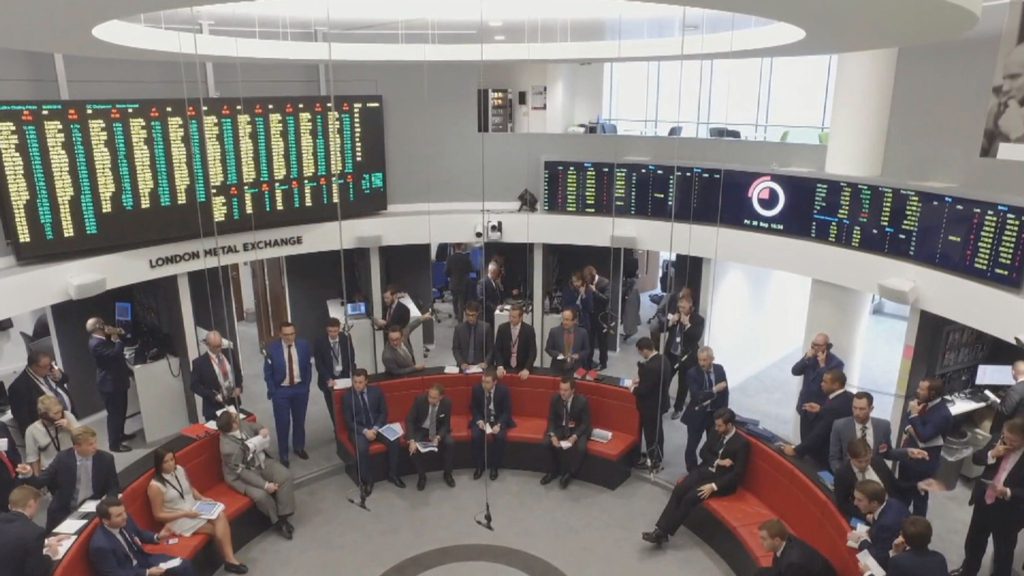LME nickel price limps back but tensions are not going away

(The opinions expressed here are those of the author, Andy Home, a columnist for Reuters.)
London Metal Exchange (LME) three-month nickel is currently trading at $35,150 per tonne.
This is in itself something of an achievement for the exchange. It’s not been easy restarting the London nickel market after its March 8 breakdown and ensuing week-long suspension.
Since trading resumed on March 16 we’ve had four limit-down days and two limit-up days, briefly interrupted by a day of almost normal trading on March 22. Official and closing prices have been declared “disruption events” six times.
The LME, new to price limits, has been learning as it goes. It’s had to incrementally widen nickel’s price band from 5% to 15% and on Thursday banned the placing of orders outside of the limits to stop traders gaming the system.
It seems to be working. Nickel traded a wide $34,500-40,700 range on Friday morning but held within the lower limit at $31,650 and the upper limit at $42,820 per tonne.

Whether such orderly conduct will last the full day remains to be seen.
The nickel market is going to remain unruly until there’s a resolution of the underlying causes of the breakdown.
Get me out of here!
This nickel crisis was triggered by the size of short positions – many of them structured in the over-the-counter shadows – held by Chinese steel and nickel giant Tsingshan Group Holding.
Tsingshan has a standstill agreement on those positions with a group of banks, meaning they won’t be closed out or margined while a standby liquidity facility is negotiated.
They will probably be rolled forward to allow a phased reduction but while they exist, they have the potential to be disruptive.
Nor is Tsingshan the only player with a short position on the LME. Hedge short positions are common price-offset strategies among producers and if they’re ferro-nickel or nickel sulphate producers, they’re in the same boat as the Chinese company with no option of delivering their product against the LME’s high-specification nickel contract.
The LME’s futures banding report shows four significant short positions sitting on the April third-Wednesday prompt date, including a big one equivalent to 30-40% of open interest. There are also four sitting on both the May and June dates.
Given LME nickel was trading below $25,000 per tonne at the start of the month, it’s likely those short-position holders will also be feeling the margin pain and looking to reduce or exit just as soon as they can.
On the other side of the ledger sits a dominant long position, controlling between 40% and 50% of available LME stocks.
The positioning landscape suggests a suspension but no resolution of the bull-bear clash that helped generate the market meltdown.
LME stocks still falling
Nor has much changed in the underlying dynamics that propelled the price so high before the suspension.
LME warehouse stocks have continued sliding. True, there’s been a wholesale reshuffle of cancelled metal back onto LME warrant with open tonnage now at 55,488 tonnes, compared with an early March low of 36,522 tonnes. But the headline figure has fallen another 6,600 tonnes so far this month and at 72,924 tonnes is the lowest it’s been since December 2019.
The electric vehicle battery sector’s demand for the high-grade Class I nickel in LME warehouses continues unabated.
Questions around the status of Russian supply in the wake of the invasion of Ukraine loom ever larger.
Norilsk Nickel, which accounts for around 17% of global Class I metal supply, hasn’t been sanctioned.
But, trapped in the Arctic north, the company’s prime shipping route is to Europe. The Netherlands is the largest-volume destination for Russian nickel exports, accounting for 60-70% of all shipments in 2019-2020. Most of the balance, interestingly, was exported to Switzerland, according to ITC trade figures.
Self-sanctioning by banks, trade houses and logistics companies is likely to generate a lot of friction in what was previously a smooth physical flow of metal.
This is particularly problematic for the LME, given only Class I nickel such as that produced by Norilsk is deliverable against its contract.
Shorts looking to effect physical delivery against their LME positions may struggle to access the liquidity pool of Russian metal that is stored in Rotterdam.
Liquidity squeeze
What its early German discoverers nicknamed the devil’s metal is going to remain devilishly tricky to trade given the continued supply uncertainty caused by what Russia terms its “special military operation”.
The overriding short-term market theme will be risk reduction with eye-watering margins likely to deter all but the most committed.
That, however, may not do anything to moderate price volatility, if liquidity is squeezed out of the market.
It’s worth noting that the Shanghai Futures Exchange (ShFE) nickel contract has traded enough hours to allow a wholesale rush for the exit door. Market open interest has collapsed from 265,736 contracts at the start of March to a current 118,287.
Volatility, if anything has only increased, the most active contract hitting its upper 20% limit on Friday morning.
Shanghai registered stocks remain low at 7,415 tonnes and the forward curve is still heavily backwardated.
The squeeze on Class I metal in the Chinese market predates this year’s run on LME stocks and it shows no signs of being over any time soon.
Low stocks and falling liquidity may be a harbinger of what the LME market will look like in a couple of months time.
Before then, though, there is still the unresolved issue of Tsingshan’s big shorts to be navigated.
The LME’s nickel problems could be far from over.
(Editing by Kirsten Donovan)
More News
Rio Tinto, Founders Factory’s Mining Tech Accelerator invests in startups from US and OZ
April 23, 2025 | 04:02 pm
{{ commodity.name }}
{{ post.title }}
{{ post.date }}



Comments